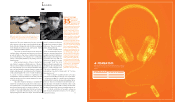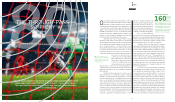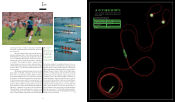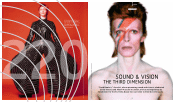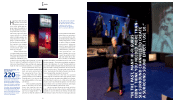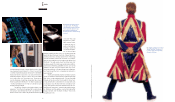Sennheiser 2012 Annual Report Download - page 16
Download and view the complete annual report
Please find page 16 of the 2012 Sennheiser annual report below. You can navigate through the pages in the report by either clicking on the pages listed below, or by using the keyword search tool below to find specific information within the annual report.
31
440 Hz
30
440 Hz
OPERA MUSICIANS
440
There is an air of excitement and expectation when you
enter an opera house. People scurrying to arrive on
time while others enjoy a glass of champagne or wait
outside in the hopes of getting a ticket to an already sold-
out performance. And as they begin to take their seats, the
audience is greeted by a wild cacophony of sound as up 100
orchestra members warm up for the performance by playing
scales or taking one last opportunity to practice a particu-
larly difficult passage. The theater pulsates with the expec-
tation of the evening to come and heightened adrenaline as
– behind the stage – soloists and choir, conductor and
orchestra, prompter, technicians and stage managers
prepare for the curtain to go up on an evening that will take
on a life of its own.
And then – suddenly – absolute silence. That is, until
the first oboeist of the evening puts his lips to reed and
begins to play. Like a snake charmer, the oboist’s clear,
haunting tone seems to cast a spell on the other orchestra
members who, without word, take up their own instruments
to join in the master’s one-note song – “A.”
It is a ritual that has taken place since the 16th
century, when early masters of the Baroque Giovanni Gabri-
eli and Claudio Monteverdi began laying the groundwork for
the modern orchestra and opera. And yet, in a musical era
marked by the orderly progression of tonal harmony, a
striking dissonance soon began to resonate between the
singers and instrumentalists: at what frequency should the
pitch “A” be tuned?
Pitch is an auditory sensation that employs a cycle
of vibrations per second (hertz) to assign notes on the mu-
sical scale. However, unlike frequency in physics, which is a
pragmatic science based on the characteristics of wave-
lengths, pitch is the result of what we hear and, as such, can
be extremely subjective. Like economic inflation, it tends to
rise and fall according to demand.
During periods in which instrumental music rises in
prominence relative to the voice, the tendency is for the
concert pitch, the pitch used to tune the orchestra, to rise as
well. That’s because, when tuned at a higher frequency, the
increased tension of the strings gives string instruments a
brighter, more brilliant sound. The singer’s dilemma is that
the physiological function of the vocal cords is better suited
to a lower concert pitch. In the Baroque period, for instance,
the tuning of A fluctuated wildly between 392 cycles per
second (A392) and 440 cycles per second (A440), a differ-
ence of almost one whole tone, lead-
ing German composer and leading
music academic of his time Michael
Praetorius to report how “pitch levels
had become so high that singers were
experiencing severe throat strain.”
The classical period is particu-
larly noteworthy for its lack of pitch
inflation. Looking to emulate the aes-
thetics of classical antiquity, the con-
cert pitch was generally calculated
Every orchestra is tuned to one single pitch. The higher it is, the
brighter and more brilliant the instruments sound – and the more
difficult it makes it for the singers. The history of a centuries-long
struggle to establish the frequency of a single tone: “A.”
THE GREAT
PITCH INFLATION
A GOOD VIBE
256According
to legend,
passing
black-
smiths at work, Pythagoras stopped
to enjoy the beauty of the anvils as
they were being struck. In doing so,
he discovered a simple and uniform
mathematical relationship between
the frequencies. Later efforts to set
the concert pitch according to the
purity of the Pythagorean method
failed.


